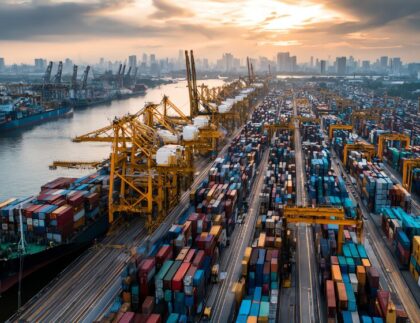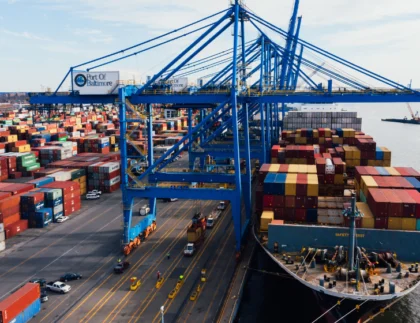
The freight forwarding industry is moving into one of its most transformative periods.
By 2026, digitalization, rapid shifts in global trade, and growing customer expectations will reshape how logistics partners operate.
While large multinational freight forwarders continue expanding their global networks and tech capabilities, small and mid-sized freight forwarders still have powerful opportunities to thrive, if they adopt the right strategies.
In fact, many shippers are actively seeking alternatives to big players, craving flexibility, responsiveness, and personalized services that large forwarding enterprises often struggle to deliver at scale. With smart positioning and the right investments, smaller forwarders can build a competitive edge in the evolving logistics market of 2026.
1. Lean Into Agility: The Advantage Giants Don’t Have
Large freight forwarders are powerful, but they’re also complex. Their size slows decision-making and limits the degree of customization they can offer. Small and mid-sized freight forwarders can capitalize on this by maintaining:
- Faster responses: Clients value quick updates, real-time decisions, and hands-on support—something SMEs can deliver better than big corporations bogged down by layers of bureaucracy.
- Flexible solutions: Unlike larger companies with rigid systems, smaller forwarders can design tailored logistics solutions for niche markets, emerging trade lanes, or specialized cargo.
- Closer customer relationships: Personalized attention is a major selling point. Many shippers prefer working with a team that knows their business intimately rather than being “just another account.”
2. Adopt Digital Freight Technology—Smartly and Selectively
Digitization is no longer optional; it’s a core part of freight forwarding strategies in 2026. But small and mid-sized forwarders don’t need the massive tech budgets giants have. Instead, they can focus on cost-effective digital tools that deliver the highest ROI.
Essential technologies include:
- Cloud-based TMS platforms for shipment tracking, booking, and invoicing
- AI-driven route optimization to cut delays and improve efficiency
- Automated documentation tools to reduce errors in customs and compliance
- Real-time visibility platforms that customers can easily access
- Digital quoting systems for faster communication and improved accuracy
Why this matters
Digital freight technology helps smaller forwarders look bigger than they are. By offering modern customer portals and automated workflows, SMEs can inspire confidence and compete directly with the polished digital experiences of industry giants.

3. Specialize in Niche Markets Instead of Fighting Everyone
Trying to compete with global leaders across all markets is unrealistic. Instead, small and mid-sized freight forwarders can win by becoming the best in niche verticals where personalized knowledge matters more than scale.
High-potential niches include:
- E-commerce fulfillment for SMEs
- Perishables and temperature-controlled logistics
- Hazardous materials or oversized cargo
- Trade lanes underserved by global forwarders
- Industry-specific supply chains such as fashion, automotive parts, or pharmaceuticals With specialized know-how, SMEs can create unmatched value and justify premium pricing.
4. Form Strategic Partnerships That Multiply Capabilities
Partnerships are one of the most effective logistics competitiveness strategies for 2026. By collaborating rather than trying to build everything in-house, SMEs can expand their reach, resources, and operational capacity.
Types of valuable partnerships:
- Agent networks to strengthen global presence
- Digital freight platforms to access new customers
- Local ground transport providers for seamless last-mile delivery
- Warehouse operators for bonded storage or value-added services
Working with the right partners allows smaller forwarders to offer service coverage that rivals top-tier players—without the cost or operational burden.
5. Highlight Transparency and Reliability as Core Value Propositions
In a market crowded with large and small freight companies, trust has become a deciding factor for many shippers. Small and mid-sized forwarders can stand out by delivering:
- Clear, proactive communication
- Clients expect updates before they ask for them.
- Accurate, upfront pricing
- Hidden fees are a major frustration in global logistics. Transparent rate structures build long-term loyalty.
- Consistent service quality
- Smaller teams can ensure uniform processes, something large companies struggle with across multiple divisions and regions.
6. Build a Strong Digital Presence and Brand Identity
In 2026, a forwarder’s online presence is as critical as its physical warehouses. To attract new customers, especially tech-savvy SMEs, smaller forwarders need:
- A modern website showcasing services and capabilities
- Clear messaging about what makes them unique
- Case studies and testimonials
- Active participation in digital freight marketplaces
- Social media visibility to support brand credibility
Being digitally present also helps SMEs appear more established, closing the perceived gap between them and global forwarding giants.

7. Invest in Supply Chain Innovation Without Overextending
Innovation doesn’t always require expensive technology. Many impactful improvements come from enhancing processes, training teams, or optimizing how information flows.
High-impact innovations for smaller forwarders:
- Using predictive analytics to anticipate delays
- Offering green logistics options to attract sustainability-focused customers
- Introducing self-service dashboards for client convenience
- Optimizing warehouse layouts for faster handling
- Implementing data-driven decision-making
Even small operational improvements compound over time, boosting productivity and profitability.
8. Focus on Value-Added Services (VAS)
By 2026, shippers expect more than just transportation. SMEs can differentiate themselves through VAS such as:
- Customs brokerage
- Cargo insurance
- Packaging and labeling
- Quality inspections
- Local warehousing or fulfillment
- Reverse logistics (returns handling)
These services deepen client relationships and open new revenue streams beyond traditional freight forwarding.
9. Strengthen Customer Education and Advisory Services
Many clients—especially small to mid-sized shippers—don’t have deep logistics knowledge. Freight forwarders who act as advisors rather than just service providers can build significant trust.
Examples of advisory strengths:
- Helping clients optimize their supply chain
- Providing regulatory guidance
- Recommending more efficient shipping modes
- Offering insights on current freight forwarding trends
- Educating customers on new trade policies or disruptions
This advisory role makes the forwarder indispensable and reduces customer churn.

Conclusion: The Future Is Bright for Small & Mid-Sized Forwarders
Competing with large freight forwarders in 2026 isn’t about matching their size or spending power. It’s about leveraging strengths that the giants can’t easily replicate—agility, personal service, specialization, and smart use of digital tools.
Small and mid-sized freight forwarders who embrace innovation, deepen their expertise, and deliver exceptional customer experiences will not only compete but thrive in the evolving logistics landscape. The industry is shifting quickly, and the forwarders who adapt earliest will capture the most opportunity.











